
Here we are to introduce and comment one of the most beautiful reef tanks I’ve ever seen. Most of all, we’d like to admire the skill of Andrea Negusanti, aka AndreaNegu, who was able to have as many as two of his tanks awarded as “tank of the month”. We’re also proud to have Andrea as the centerpiece of our Italian-pizza-and-aquarium-lovers group “MagnaRomagna“.
Andrea’s tank was tailored in order to fit into his home environment and is based on a custom Elos tank (125x70x55) entirely made in extra clear glass 15 mm thick. The tank’s gross capacity is 480 liters, which is also the system’s overall capacity, also considering sump volumes.
The tank leans on a metal frame custom made by
Andrea himself and covered with solid wood. The result is very aesthetically pleasant. Andrea’s frame customization includes a second right door, provided with a beautiful aperture in order to dissipate the heat of the inside-placed chiller. I also adopted the same solution, as shown in this
tutorial.

The aquarium was transferred from the previous, equally beautiful, tank. Special care was taken in order to reduce the amount of rocks and preserve the most valuable and beautiful animals. The reduction of the amount of rocks and the subsequent lessening of TVC*, implied a long development time in order to reach a full equilibrium. The removal of the rocks has a significant aesthetic impact, as shown in the pictures, but increases development time and the overall equilibrium. As a rule of thumb, you should know what you do before changing the Berlinese rules, which implied the rock / water ratio of 1 kg / 8 lt. In that case, Andrea should have used at least 60 kg of rocks but he actually used only a little less than 35 kg. The result was astonishing but was very hard to reach.

Acropora tenuis
Technical specifications
The original sump was square, 60 cm wide, with separate refilling tank, but Andrea recently replaced it with a new PVC sump created by LGMAquari.
The technical equipment is entirely from LGMAquari, with a double – pump skimmer LGs950 and a calcium reactor LGr1401.
In the last few weeks, Andrea has also been testing the new
tunze Doc Skimmer 9415. We hope to be able to publish some comment about it.

A 300 watt heater and a fluidized bed filter Deltec, in order to eventually use resin, complete the equipment.
Actually the filter is used with a low amount of biopellets, but Andrea needs more time in order to evaluate their effectiveness.

During the summer, in order to mitigate the heat, Andrea uses some redundant cooling systems: a Teco TR 15 with Teco E-Chill double fan and his domestic air conditioning system. All the systems are fed by solar energy coming from solar panels.
The result is a mild temperature all year round. This promotes tank oxygenation and eliminates overheating problems, with several benefits, as you can see in the picture.
In order to avoid pH reduction due to low ventilation caused by the air conditioning system, the entire house is constantly ventilated. There is no energy waste, thanks to the solar plant.

The tank is served by a dedicate, shielded switchboard placed in sump. The switchboard is divided from the “wet part” by a plywood panel, magnetically attached, easy to remove and replace. Simply smart. In the picture, the panel has been removed.

The aquarium is also equipped with an Ocean Life Zeus UPS custom made for aquariums, feeding a return pump, positioned away from the tank, to save space in sump.
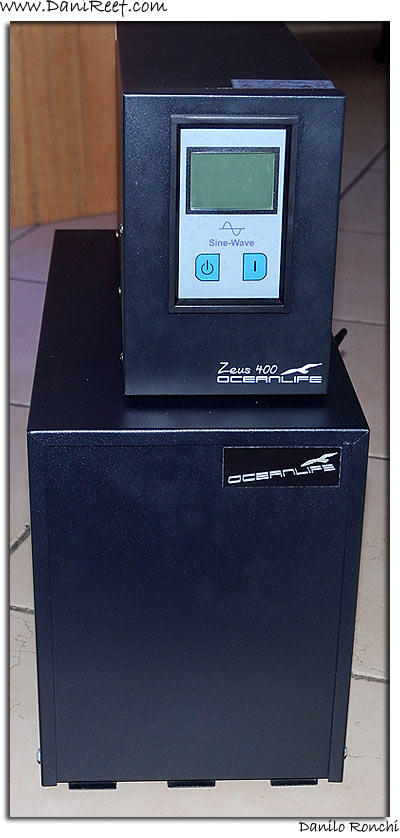
Lighting System
By default, the tank was equipped with an old, self-built T5 lamp with 10 tubes, 54 W each, together with two blue LED bars, to enhance LPS coral fluorescence.

The next step, however, consisted in opting for HQi lamp, against the usual trend.
“
The results I’ve got in my aquariums – reports Andrea
– were obtained thanks to T5 lamps, but I was so curious to test something considered better that, instead of switching to LED (still expensive, even today and uncertainly performing), I chose to adopt the safer solution, using HQi lamps, choosing an Elos E-Power with tho 14.000°K, 250 W-each lamps and one blue E-lite with 3 red led. After ten months of use, I can rightfully say to be extremely happy with this solution. Corals are astonishing and I’ve got colors never seen with the T5. Even if some coral lost something in environmental colors, the majority of them gained a very marked improvement. The overhead light has a single flaw: the blue lighting on the aquarium’s edges is insufficient and I’m currently working in order to improve it, adding more LEDs on the external sides of the Epower”
.
In order to get a better blue-LED calibration and a wonderful dimmering scenic effect, Andrea also used Elos Tempo+Dimmer module, which enables to modulate blue-LED intensity when switching on and off.
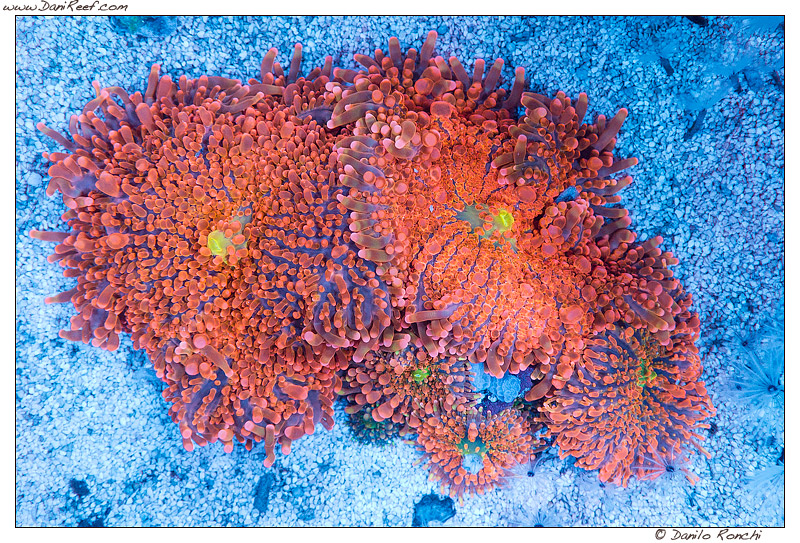
Ricordea florida under blue led
The flowing
After a long cost/benefits analysis and some tests on a
vortech pump, Andrea decided to adopt
Tunze pumps, using two
electronic Tunze Nanostream 6095, controlled by
7094 multi controller, in order to simulate wave motion and stillness during the night. Andrea is also using another electronic
Nanostream 6055 and 6040 carefully placed behind the rocks, to prevent stagnant zones in aquariam. Andrea’s relentless fight against noise prevailed over any other consideration and the pumps are completely
silent.

Acanthurus lineatus
Andrea told to us:
“Some years ago, I tested a vortech pump, but the noise was so high, compared to my standards, that the next morning the pump was dismantled and brought back. My aquarium is completely noiseless. I’m aware I’m a little picky about noise but I won’t accept any compromise. tunze pumps are perfect for me, regarding flow and noise, that, luckily, is almost completely absent”.

Stylophora pistillata milka polips
At last, we can’t forget to mention the Eheim 1262 pump, which is used as return pump and, partially, as movement pump, considering its huge capacity. Andrea built a net of PVC pipes in order to distribute pump’s capacity towards at least 3 different filters. One of these branches is actually used to serve calcium reactor.

Acanthurus achilles
The Manteinance
Now we are curious to know why Andrea’s tank is so successful.
“Starting from a serious technical base, I think that our sensibility can make the difference. For me is very important to change at least 10% of aquarium’s water volume every 15 days. The activated carbon is replaced once a month and kept constantly in aquarium and, if needed, I also replace PO4 resins. Every two months, I perform a general deep cleaning: pump, filters, sump deposit, trying to keep everything clean as much as I can“.
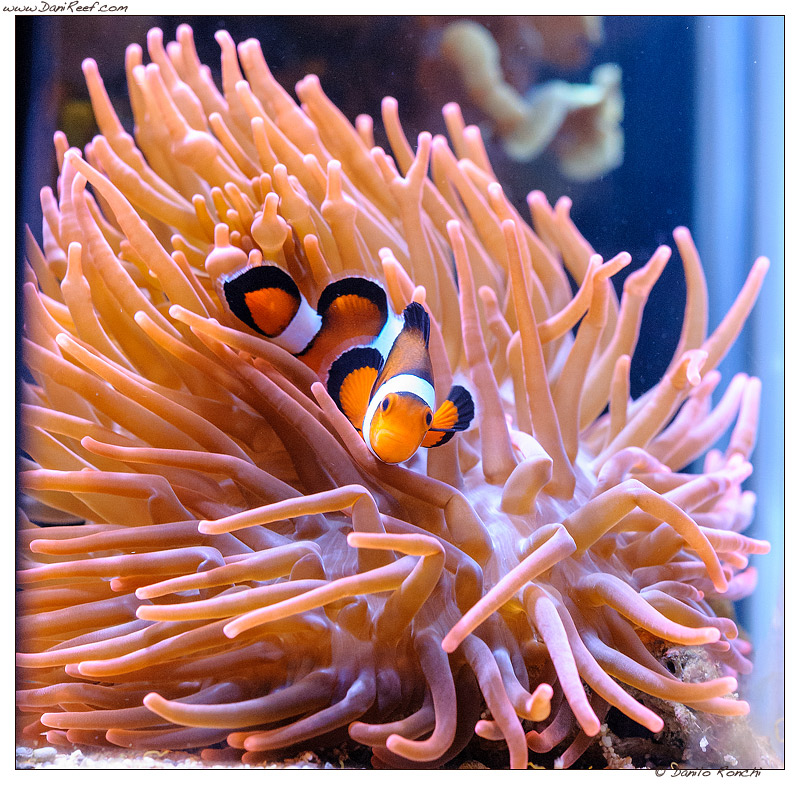
Ampiphrion ocellaris inside Enctamea quadricolor
But maintenance itself is not enough to achieve so brilliant results. So, tell us your secret!
“I don’t like to feed invertebrates too much – says Andrea and I mistrust him a little bit because I don’t completely agree with him – because I don’t’ like to pollute the aquarium. Anyway, I use the complete Elos protocol with Omega amino-acids, ProSkimmer and zooplancton sold by Elos with the EVC commercial name. The protocol is absolutely excellent but I won’t reveal the exact doses :)”…

Pocillopora damicornis tricolor
How about fishes? “This pollution – control protocol affect fishes, also – says Andrea – but I like to feed them directly at least twice a day with Elos SVM 2 and Fauna Marin ultra marine soft shrimp and spyrulina seaweed. Every two days, I also add Nori seaweed rigorously bought at supermarket”.

Zebrasoma flavescens
There’s only one thing to ask Andrea: how about the aquarium values?
“I try to keep them constant all year round, starting from temperature: 26°C. Nitrates and nitrites cannot be traced, even if I’m trying to keep their concentration even lower, using biopellets, in order to better enhance corals’ colors”. While he says that, I look at him and smiling, considering the remarkable colors in aquarium. Most of all beacuse no bacterial proliferation method (which enhances coral’s colors) is used.
“There’s a very small amount of phosphates and in that case I use resins but the average value is 0,01 mg/l. Calcium reactor, instead, helps to keep Kh value at 7, more or less, which allows Ph variation between 8 and 8,20 with huge benefits for corals. Calcium is at more or less 400 ppm and magnesium at 1200 ppm: perfect 1:3 ratio”.

Tridacne
You don’t seem to use any automated control system for your tank, like Aquatronica, Biotopus, Limulus… Why?
“To be honest, sooner or later I’d like to join automation world but I feel quite old – fashioned about this issue. I enjoy feeling the aquarium, keeping everything under control and doing everything by myself. Also, the switchboard I built manages everything thanks to the timer so, at the moment, I don’t need to automate something which, as a matter of fact, is already automated since its construction.But I’m interested in a system capable of detecting chemical parameters, like pH, Redox and, also, a telephone warning unit in order to send alert signal in case of troubles with the tank. I’d also like to add to the system the Elos E-vision unit, adding it to Elos tempo+dimmer module that I just have to manage the overhead light. At the moment I monitor the situation, ready to grab a convenient offer“.
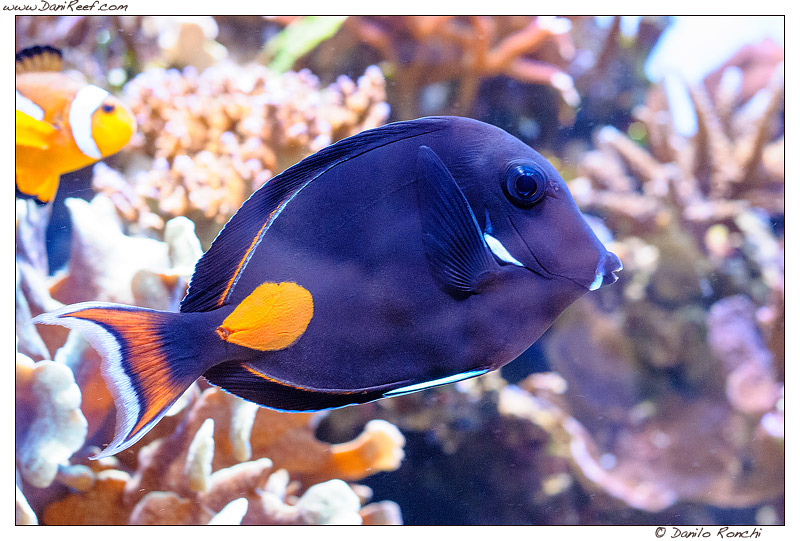
Acanthurus achilles

Seriatopora caliendrum
Animals
Your tank recalls the exact idea of Dutch aquarium in sweet water: a relatively small amount of fishes but mostly a huge coral numbers. What can you say about that?
“My idea has always been to focus on very special kinds of coral and fishes. My concern was so intense that I have recently removed from the tank a wonderful Acathurus leucosternon in order to insert one of my long awaited dreams: a spectacular Acanturus achilles. At the beginning I tried to make them coexist, but in the long term, I’ve experienced a growing intolerance in leucosternon and a growing fear in achilles, so I was forced to take a decision“.

Synchiropus picturatus
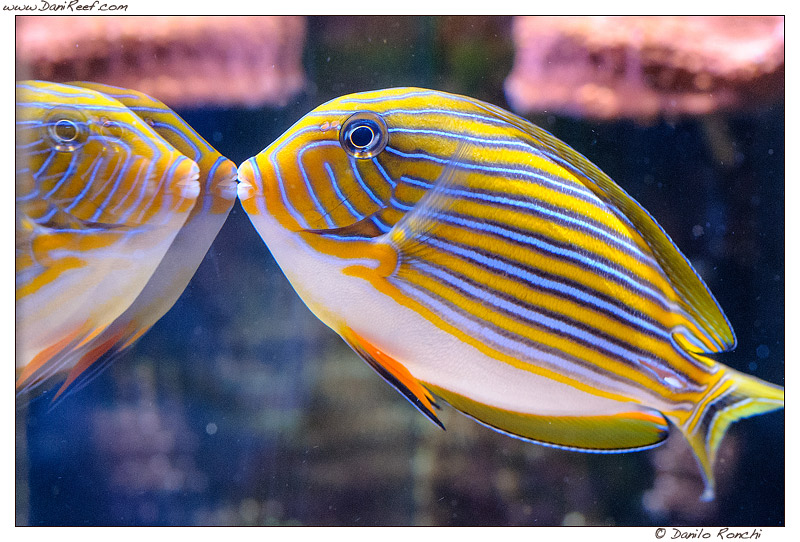
Acanthurus lineatus
And, glancing at the tank, we know that Andrea made the right choice. Yet a leucosternon is not for everyone but an achilles is even more peculiar.
“There are also other fishes, all carefully chosen, like the Calloplesiops altivelis, called Camomilla (chamomile), in honor of the wonderful Calloplesiops you used to have in your tank for nine years with the same name“.
We feel very honored…

Calloplesiops altivelis

Calloplesiops altivelis
“According to my philosophy, then, I added two couples of Synchiropus, marmoratus and picturatus, cheering me with mating dances almost every evening; but I also added an Acanthurus lineatus an one Zebrasoma flavescens.
I couldn’t resist to insert also a couple of “clown fish”, Ampiphirion ocellaris. Recently, I gave them a real anemone, an Enctamea quadricolor, and I like looking at it in the evening, especially when clown fish lay eggs close to it.
Once the anemone was placed, symbiosis started immediately: so wonderful!“
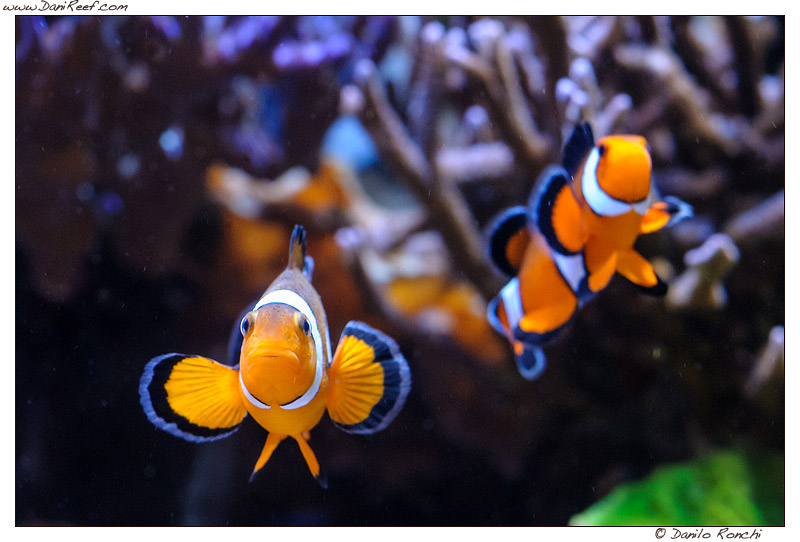
Couple of Ampiphrion ocellaris
“A single specimen of Pseudoanthias squamipinnis remains. Once there was a group of them but now only one remains and I’m not sure to insert others of them or totally different fishes“.
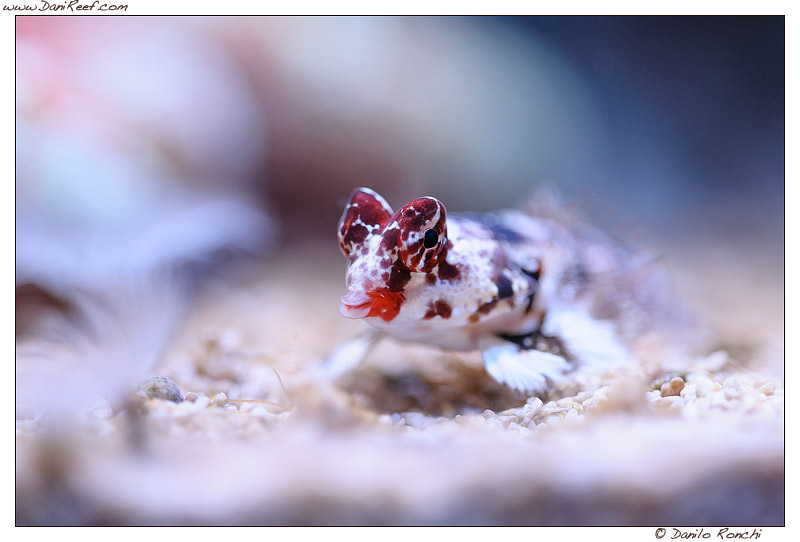
Synchiropus marmoratus
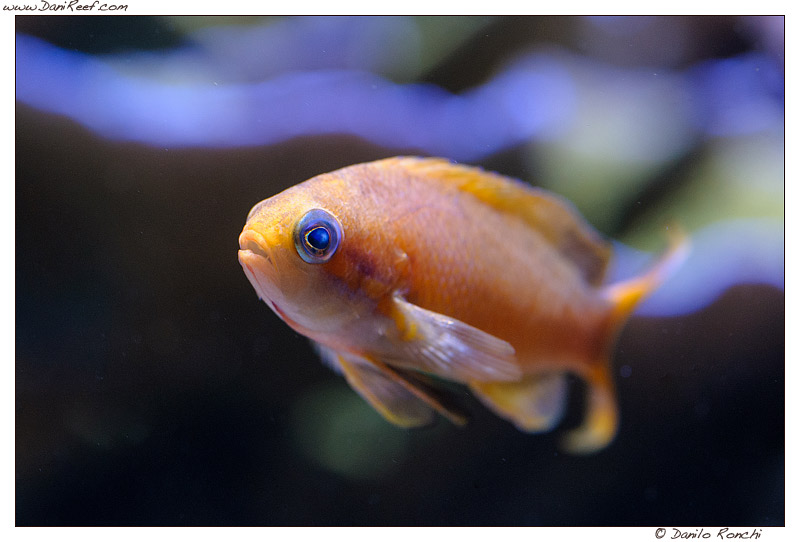
Pseudoanthias squamipinnis
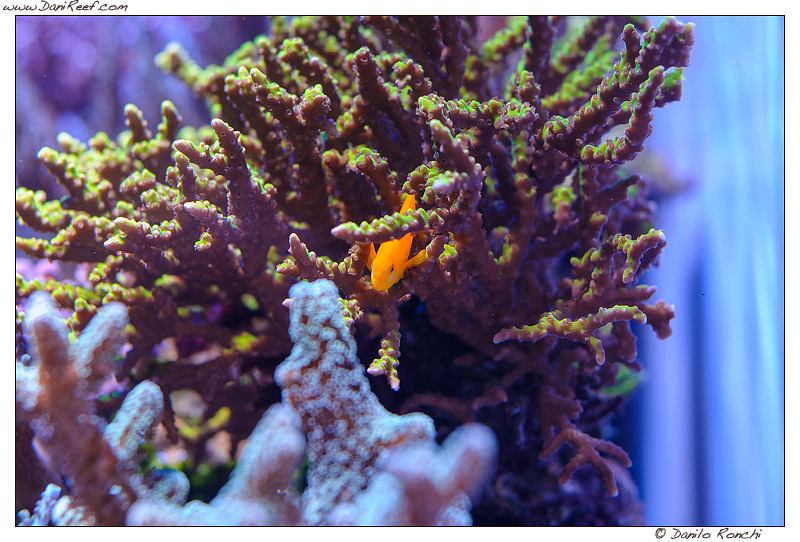
Gobiodon okinawe inside of Anacropora sp.

Stenopus hispidus
Corals
As you can see, the aquarium was built to fit mainly corals, LPS and SPS.

Zoanthus sp.
Andrea tells us why with his own words: “I always loved corals, so I tried to build aquarium in order to accommodate them. My target was to buy beautiful and very colored animals. As you can see with my “tridacne” together with my Stilophore, Pocillopore and Acropore. And I hope you like my aquarium as much as I do“.

Green polyps of Seriatopora histrix
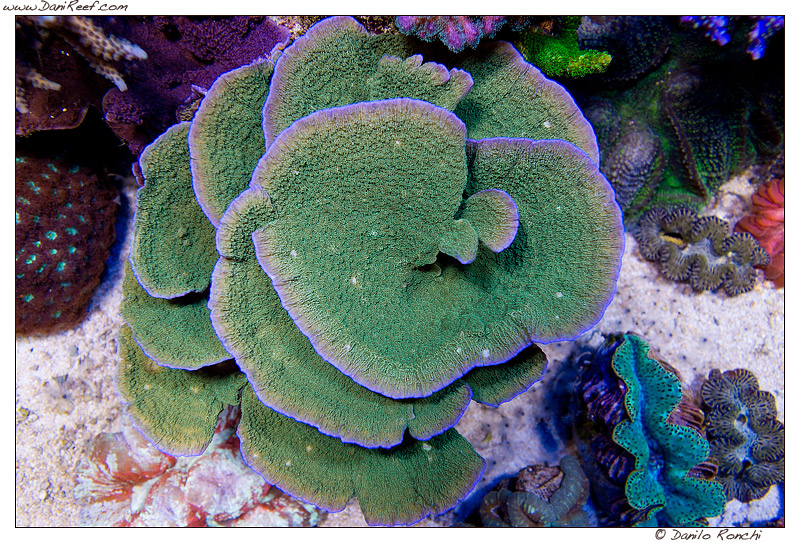
Montipora foliosa

Tridacna

Acropora selago
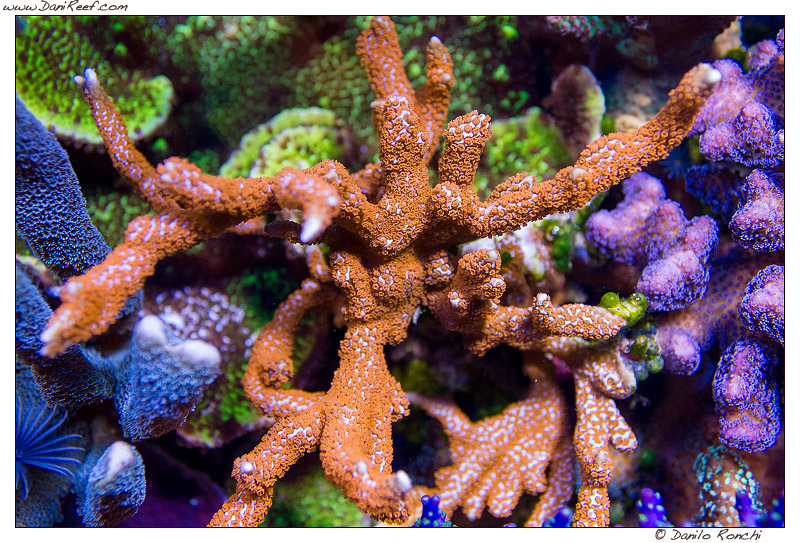
Montipora samarensis

Polips of incredible wonderful Acropora tenuis

Pavona cactus

Acropora granulosa
The beautiful part of modern lighting and Elos Epower with Manta and Elite is to have the LED and so it’s possible to admire the same corals’ pictures enhancing fluorescence, even if some colors are quite different from the colors you see with white aquarium lights, especially with LPS corals.

Acanthastree

Lobophyllia hemprichii

Fungia

Blastomussa

Trachyphyllia, tridacna and Cynarina

Zoanthus

Acanthastrea
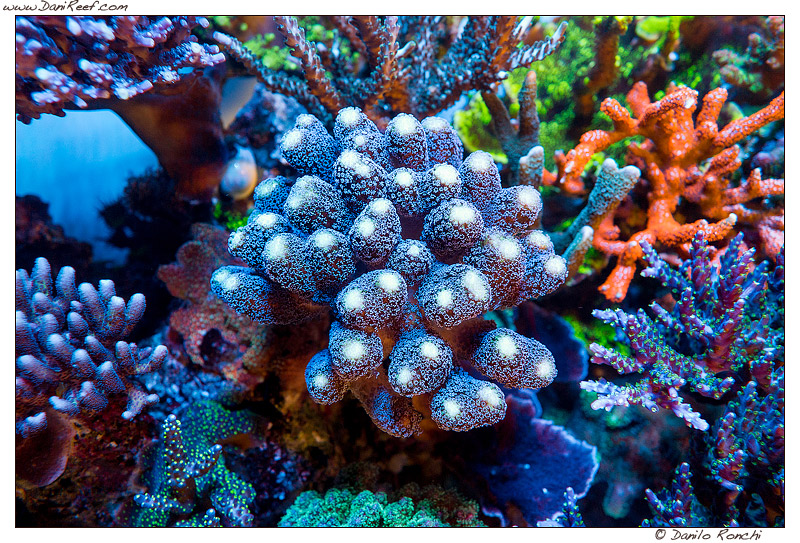
Stylophora pistillata milka under blue led
Acknowledgements
Do you like to thank someone? Even if it’s difficult to think that you have to say thanks to someone, considering the results you achieved.
“Actually yes: I have to say thank you to many people: to my family, which lets me cultivate my hobby even if this subtracts time to my dearest. From a technical point of view, I need to say thanks to my friend Simone, owner of my trusted aquarium shop in Pesaro: AFP Acquari. I’m also glad to be a part of MagnaRomagna, where we frequently meet each other and cultivate our passion, spending quality time together and carrying on several projects which allowed me to see so many tanks, fairs (Nurnberg, mainly) and meeting so many aquariophiles.
Last but not least, a special thank you goes to Danilo Ronchi, aka DaniReef, I also have to thank you for the wonderful pictures“.
Thanks to you!


Acropora valida
We are waiting for your comments and questions.

























































0 Comments